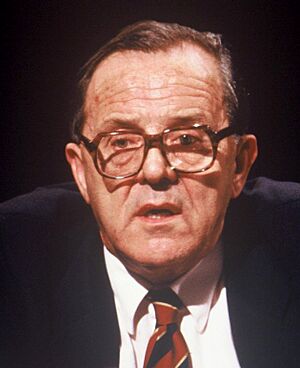Merlyn Rees facts for kids
Quick facts for kids
The Lord Merlyn-Rees
|
|
|---|---|

Merlyn Rees on After Dark in 1988
|
|
| Shadow Secretary of State for Energy | |
| In office 4 November 1980 – 24 November 1982 |
|
| Leader | Michael Foot |
| Preceded by | David Owen |
| Succeeded by | John Smith |
| Shadow Home Secretary | |
| In office 4 May 1979 – 4 November 1980 |
|
| Leader | James Callaghan |
| Preceded by | William Whitelaw |
| Succeeded by | Roy Hattersley |
| Home Secretary | |
| In office 10 September 1976 – 4 May 1979 |
|
| Prime Minister | James Callaghan |
| Preceded by | Roy Jenkins |
| Succeeded by | William Whitelaw |
| Secretary of State for Northern Ireland | |
| In office 5 March 1974 – 10 September 1976 |
|
| Prime Minister | |
| Preceded by | Francis Pym |
| Succeeded by | Roy Mason |
| Shadow Secretary of State for Northern Ireland | |
| In office 24 March 1972 – 4 March 1974 |
|
| Leader | Harold Wilson |
| Preceded by | Position established |
| Succeeded by | Francis Pym |
| Member of Parliament for Morley and Leeds South (Leeds South 1963–1983) |
|
| In office 20 June 1963 – 16 March 1992 |
|
| Preceded by | Hugh Gaitskell |
| Succeeded by | John Gunnell |
| Personal details | |
| Born |
Merlyn Rees
18 December 1920 Cilfynydd, Wales |
| Died | 5 January 2006 (aged 85) London, England |
| Nationality | British |
| Political party | Labour |
| Spouse |
Colleen Cleverly
(m. 1949) |
| Children | 3 |
| Alma mater |
|
Merlyn Merlyn-Rees, Baron Merlyn-Rees (born Merlyn Rees; 18 December 1920 – 5 January 2006) was an important British politician. He was a member of the Labour Party. He served as a Member of Parliament (MP) from 1963 to 1992. During his career, he held two very important jobs: Secretary of State for Northern Ireland (1974–1976) and Home Secretary (1976–1979).
Contents
Merlyn Rees: A British Politician
Early Life and Education
Merlyn Rees was born in a place called Cilfynydd, near Pontypridd, in Glamorgan, Wales. His father, Levi Rees, was a war veteran. The family moved to England so his father could find work.
Merlyn went to Harrow Weald Grammar School in Harrow, England. After school, he studied at Goldsmiths College in London. While there, he was the president of the students' union.
Serving in the Royal Air Force
In 1941, Merlyn Rees joined the Royal Air Force (RAF). He became a squadron leader, which is a high rank. His friends in the RAF gave him the nickname "Dagwood."
He served in Italy during World War II. He worked as an operations and intelligence officer. After the war, he decided not to stay in the RAF.
Becoming a Member of Parliament
After his time in the RAF, Rees studied at the London School of Economics. He earned two degrees in economics. Then, in 1949, he became a schoolmaster at his old school in Harrow. He taught economics and history for eleven years.
In 1963, Merlyn Rees became a Member of Parliament (MP). He won a special election for the Leeds South area. He took over the seat from the former Labour leader, Hugh Gaitskell, who had passed away. He continued to represent this area until 1992.
Working for the Government
In 1965, Rees started working in government roles. He became a Parliamentary Under-Secretary at the Ministry of Defence. He was in charge of the army first, and then the Royal Air Force.
Later, from 1968 to 1970, he worked at the Home Office. This is a government department that deals with law and order.
Secretary for Northern Ireland
In 1974, when the Labour Party came back into power, Merlyn Rees was given a very important job. He became the Secretary of State for Northern Ireland. This was a challenging time for Northern Ireland.
He tried to bring peace and stability to the region. He even tried to involve some groups in the political process. However, some groups continued to cause problems. He wrote a book about his experiences called Northern Ireland: a Personal Perspective.
Home Secretary Role
In September 1976, Merlyn Rees was given another major role. He became the Home Secretary. This meant he was in charge of policing, security, and immigration for the whole country. He stayed in this job until 1979.
Life After Parliament
In 1992, Merlyn Rees decided to leave the House of Commons. When he retired, he was given a special honour. He became a life peer, which means he could sit in the House of Lords. He was known as Baron Merlyn-Rees.
He also became the first Chancellor of the University of Glamorgan in Wales. He held this position from 1994 to 2002. He was also president of the Video Standards Council from 1990.
Family and Later Years
In 1949, Merlyn Rees married Colleen Cleveley. They had three sons together.
In his later years, Merlyn Rees had some falls. In late 2005, he had a fall at his home. He passed away on 5 January 2006, at the age of 85.
His Lasting Impact
Merlyn Rees is remembered in a few ways. A street in Morley, West Yorkshire, is named after him: Merlyn Rees Avenue. Also, a school in Leeds was named Merlyn Rees Community High School for a time.
Further Reading
- Merlyn Rees, "Northern Ireland: a personal perspective", London: Methuen, 1985.

